Case or CASE may refer to:
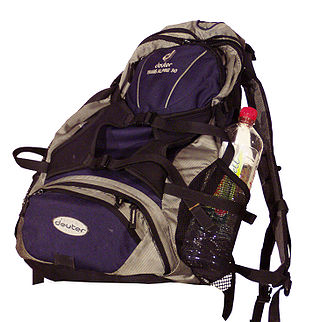
A backpack—also called knapsack, schoolbag, rucksack, pack, booksack, bookbag, haversack or backsack—is, in its simplest frameless form, a fabric sack carried on one's back and secured with two straps that go over the shoulders; but it can have an external or internal frame, and there are bodypacks.

A zipper, zip, or fly, formerly known as a clasp locker, is a commonly used device for binding together two edges of fabric or other flexible material. Used in clothing, luggage and other bags, camping gear, and many other items, zippers come in a wide range of sizes, shapes, and colors. In 1892, Whitcomb L. Judson, an American inventor from Chicago, patented the original design from which the modern device evolved.

A pocket is a bag- or envelope-like receptacle either fastened to or inserted in an article of clothing to hold small items. Pockets are also attached to luggage, backpacks, and similar items. In older usage, a pocket was a separate small bag or pouch.

A pannier is a basket, bag, box, or similar container, carried in pairs either slung over the back of a beast of burden, or attached to the sides of a bicycle or motorcycle. The term derives from a Middle English borrowing of the Old French panier, meaning 'bread basket'.
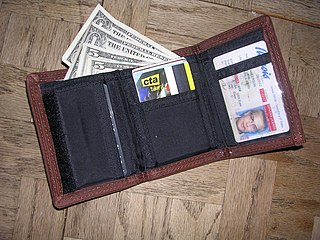
A wallet is a flat case or pouch, often used to carry small personal items such as physical currency, debit cards, and credit cards; identification documents such as driving licence, identification card, club card; photographs, transit pass, business cards and other paper or laminated cards. Wallets are generally made of fabric or leather, and they are usually pocket-sized and foldable.

Modular Lightweight Load-Carrying Equipment, or MOLLE, is the current generation of load-bearing equipment used by a number of NATO armed forces, especially the British Army and the United States Army since the late 1990s. MOLLE uses the Pouch Attachment Ladder System (PALS) webbing equipment – rows of heavy-duty nylon stitched onto the gear – to attach equipment. This method has found use on civilian gear, and as a result, the term MOLLE is used outside the military for PALS-type webbing.

A handbag, commonly known as a purse in North American English, is a handled medium-to-large bag used to carry personal items. It has also been called a pocketbook in parts of the U.S.

A clamshell design is a kind of form factor for electronic devices in the shape of a clam shell. Mobile phones, handheld game consoles, and especially laptops, are often designed like clamshells. Clamshell devices are usually made of two sections connected by a hinge, each section containing either a flat panel display or an alphanumeric keyboard/keypad, which can fold into contact together like a bivalve shell.

A waist bag, fanny pack, belt bag, moon bag, belly bag, or bumbag is a small fabric pouch worn like a belt around the waist by use of a strap above the hips that is secured usually with some sort of buckle. The straps sometimes have tri-glide slides, making them adjustable in order to fit properly. It can be considered as a purse worn around the waist.
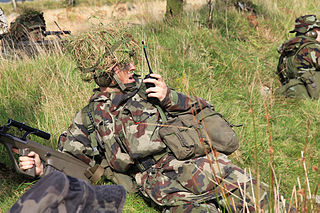
Personal load carrying equipment (PLCE) is one of several tactical webbing systems of the British Armed Forces. Dependent upon the year of design, and the decade of introduction, the webbing system was named and is commonly referred to as the 85 Pattern, the 90 Pattern or the 95 Pattern webbing.

.

A messenger bag is a type of sack, usually made of cloth. It is worn over one shoulder with a strap that goes across the chest resting the bag on the lower back. While messenger bags are sometimes used by couriers, they are now also an urban fashion icon. Some types of messenger bags are called carryalls. A smaller version is often called a sling bag.
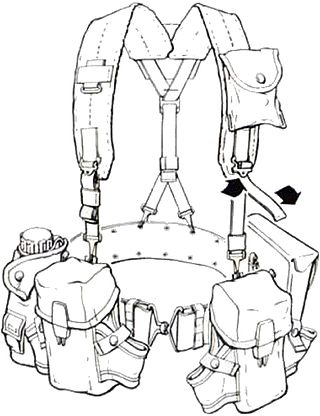
The all-purpose lightweight individual carrying equipment (ALICE) is a set of load-carrying equipment adopted as United States Army Standard A on 17 January 1973 to replace the M-1956 individual load-carrying equipment (ILCE) and M-1967 modernized load-carrying equipment (MLCE). Although since superseded by MOLLE, ALICE gear is still in some limited use with the U.S. Army National Guard, State Guard, also some ground units of the Navy and Air Force.

A satchel is a bag with a strap, traditionally used for carrying books. The strap is often worn so that it diagonally crosses the body, with the bag hanging on the opposite hip, rather than hanging directly down from the shoulder. The back of a satchel extends to form a flap that folds over to cover the top and fastens in the front. Unlike a briefcase, a satchel is soft-sided.

The IIFS was introduced in 1988, to serve as a fighting and existence carrying system—a possible replacement for the all-purpose lightweight individual carrying equipment (ALICE) employed and fielded by United States Armed Forces since 1973.

A Gladstone bag is a small portmanteau suitcase built over a rigid frame, which can separate into two equal sections. Gladstones are typically made of stiff leather and often belted with lanyards. The bags are named after William Gladstone (1809–1898), the four-time Prime Minister of the United Kingdom.
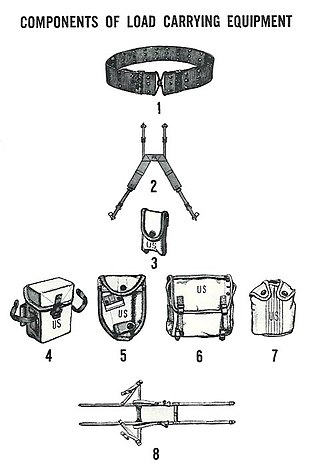
The M-1956 load-carrying equipment (LCE), also known as the individual load-carrying equipment (ILCE), was developed by the U.S. Army and first issued in the early 1960s. The M-1956 LCE was designed to replace the M-1945 Combat Pack, the M-1923 cartridge belt, the M-1936 pistol belt and the M-1937 BAR magazine belt. The M-1956 LCE was designed to be quickly configured, using no tools, to accommodate various mission and ammunition loads. The M-1956 LCE remained in service through the 1980s and set the standard for future United States military load-carrying equipment.

Golf equipment encompasses the various items that are used to play the sport of golf. Types of equipment include the golf ball, golf clubs, and devices that aid in the sport.

A bag is a common tool in the form of a non-rigid container, typically made of cloth, leather, bamboo, paper, or plastic. The use of bags predates recorded history, with the earliest bags being lengths of animal skin, cotton, or woven plant fibers, folded up at the edges and secured in that shape with strings of the same material. Bags can be used to carry items such as personal belongings, groceries, and other objects. They comes in various shapes and sizes, often equipped with handles or straps for easier carrying.



















